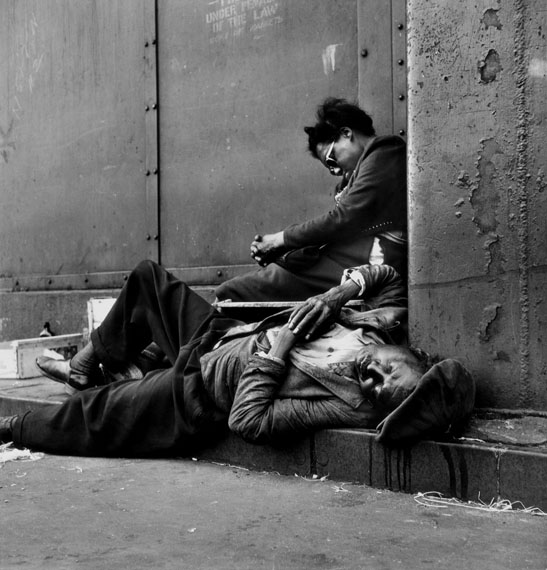
© Photograph by Gordon Parks. Courtesy of and copyright The Gordon Parks Foundation
Gordon Parks »
I am you
Selected Works 1942 - 1978
Exhibition: 8 Feb – 7 May 2017

Kunstfoyer
Thierschplatz 6
80538 München
+49 (0)89-2160 2244
kunstfoyer@vkb.de
www.versicherungskammer-kulturstiftung.de
Mon, Tue, Thu 10-18, Fri 10-20; Sat, Sun 10-18

© Photograph by Gordon Parks. Courtesy of and copyright The Gordon Parks Foundation
Gordon Parks
"I am you. Selected Works 1942 – 1978"
Exhibition: 8 February ‐ 7 May, 2017
A camera doesn’t simply take pictures. It’s a powerful tool against oppression, racism, violence and inequality – it can be enormously effective! And Gordon Parks referred to the camera as his weapon of choice and used the photographic medium his entire life in an intelligent and educational way to both expose the underbelly of the American way of life and to mediate between groups in a deeply divided society. As an important chronicler of the fight for equal rights for African-Americans, he addressed topics like poverty, marginalization and injustice, all of which have lost none of their explosive power to this day.
As their first black staff photographer, Gordon Parks had already photographed and published fashion spreads and reports with white models for Condé Nast and Life in the 1950s. Ceaselessly documenting the fight for equal rights for the black population, he also portrays the counter-world – the gangs in New York, police reaction to crime and life in poverty in the USA of the 1960s and 1970s. At the same time, Parks profiled protagonists of the American civil rights movement like Muhammed Ali, Malcolm X or Martin Luther King, Jr., but also famous artists like Duke Ellington, Ingrid Bergman or Alberto Giacometti. He also captured in images the segregation in the American South as well as the youth riots in Harlem.
In the 1970s, comprehensive cinematic works also emerged. In addition to his famous film works The Learning Tree and Shaft, he also produced numerous socially critical documentaries. With this fascinating simultaneity of glamour and misery, the commercial and humanitarian commitment of Gordon Parks’ work offers an unequalled visual social history of the USA in the 20th century. Gordon Parks hasn’t just overcome stereotypes with his work, but rather broken down thematic limits within professional photography. The content of his works reveals a constant transformation of the media. He was interested in individual and isolatable transitory moments as well as a linear narrative structure. He developed the concept of the image sequence in order to show human behavior or societal conditions as continuously repetitive processes. Gordon Parks offers singular events a temporal expansion so that they become a hybrid of static and moving images. He took photos like a cameraman, composed images like a musician and strung them together like a poet into sentences and narratives that speak volumes about their subjects.
The exhibition presented in cooperation with the Gordon Parks Foundation comprises around 180 photographs including vintage prints, contact sheets, magazines and films and correlates photographic and cinematic work. The exhibition was curated by Felix Hoffman, chief curator at C/O Berlin, and will travel to the Kunstfoyer in Munich, FOAM in Amsterdam and the exhibition spaces of the Deutsche Börse Group.
An accompanying publication will appear in the Steidl Verlag:
Gordon Parks
I AM YOU. Selected Works: 1942–1978
Published by Peter W. Kunhardt, Jr. and Felix Hoffmann
288 pages, 200 pictures, 25 x 29 cm, German
ISBN 978-3-95829-248-2, 1. publication 09/2016
€ 35 incl. Taxes�

© Photograph by Gordon Parks. Courtesy of and copyright The Gordon Parks Foundation
Gordon Parks
"I am you. Selected Works 1942 – 1978"
Ausstellung: 8. Februar bis 7. Mai 2017
Eine Kamera schießt nicht einfach nur Bilder. Sie ist ein starkes Instrument gegen Unterdrückung, Rassismus, Gewalt und Ungleichheit – ihre Wirkung kann enorm sein! Gordon Parks hat die Kamera als seine Wahl der Waffe bezeichnet und Zeit seines Lebens das Medium Fotografie intelligent und aufklärerisch genutzt, um die Schattenseiten des American Way of Life zu zeigen sowie zwischen den Gruppen einer zersplitterten Gesellschaft zu vermitteln. Als wichtiger Chronist des Kampfes für Gleichberechtigung der Afroamerikaner behandelte er Themen wie Armut, Ausgrenzung und Unrecht, die bis heute nichts an Brisanz verloren haben.
Als erster farbiger Fotograf hat Parks bereits in den 1950er-Jahren Modestrecken und -reportagen mit weißen Models für Condé Nast und Life fotografiert und publiziert. Der Zeitzeuge des Kampfes für Gleichberechtigung der farbigen Bevölkerung zeigt dazu auch die Gegenwelt – die Gangs auf den Straßen von New York, die Reaktion der Polizei auf Kriminalität, das Leben in Armut in den USA der 1960er und 1970er-Jahre. Gleichzeitig porträtiert Parks mit Muhammed Ali, Malcolm X oder Martin Luther King, Jr. die Protagonisten des amerikanischen Civil Rights Movement, aber auch berühmte Künstler wie Duke Ellington, Ingrid Bergman oder Alberto Giacometti. Zeitgleich hält er die Segregation im amerikanischen Süden sowie die Unruhen der Jugendlichen in Harlem fotografisch fest.
Ab den 1970er-Jahren entsteht zusätzlich ein umfangreiches Filmwerk. Neben seinen berühmteren Filmwerken The Learning Tree und Shaft produziert er zahlreiche sozialkritische Dokumentationen. Mit dieser Simultanität von Glamour und Elend, Kommerz und humanitärem Engagement bietet das Werk von Gordon Parks eine unvergleichbare visuelle Sozialgeschichte der USA im 20. Jahrhundert.
Gordon Parks hat mit seinem Werk nicht nur Stereotypen überwunden, sondern auch thematisch Grenzen innerhalb der professionellen Fotografie durchbrochen. Der Inhalt seiner Arbeiten lässt einen ständigen Transformator der Medien erkennen. Er war sowohl an einzelnen und isolierbaren transitorischen Momenten wie auch an einer linearen Erzählstruktur interessiert. Er entwickelte das Prinzip der Bildsequenz, um menschliches Verhalten oder gesellschaftliche Zustände als sich stets wiederholende Abläufe zeigen zu können. Einzelnen Ereignissen gibt Gordon Parks eine zeitliche Ausdehnung, so dass sie zu einem Hybrid aus statischem und bewegtem Bild werden. Er schoss Fotos wie ein Kameramann, komponierte Bilder wie ein Musiker und reihte sie wie ein Dichter zu Sätzen und Erzählungen, die viel über die porträtierten Menschen aussagen.
Die in Kooperation mit der Gordon Parks Foundation präsentierte Ausstellung umfasst 180 Fotografien mit Vintageprints, Kontaktbögen, Magazinen und Filmen und setzt sein fotografisches und filmisches Werk in Bezug. Die Ausstellung wurde von Felix Hoffmann, Hauptkurator C/O Berlin kuratiert und wird im Anschluss im Kunstfoyer in München, bei FOAM in Amsterdam und in den Ausstellungsräumen der Deutsche Börse Group gezeigt.
Ein begleitender Katalog erscheint im Steidl Verlag:
Gordon Parks
I AM YOU. Selected Works: 1942–1978
Herausgegeben von Peter W. Kunhardt, Jr. und Felix Hoffmann
288 Seiten, 200 Abbildungen, 25 x 29 cm, Deutsch
ISBN 978-3-95829-248-2, 1. Auflage 09/2016
€ 35 inkl. MwSt.�

© Photograph by Gordon Parks. Courtesy of and copyright The Gordon Parks Foundation

© Photograph by Gordon Parks. Courtesy of and copyright The Gordon Parks Foundation